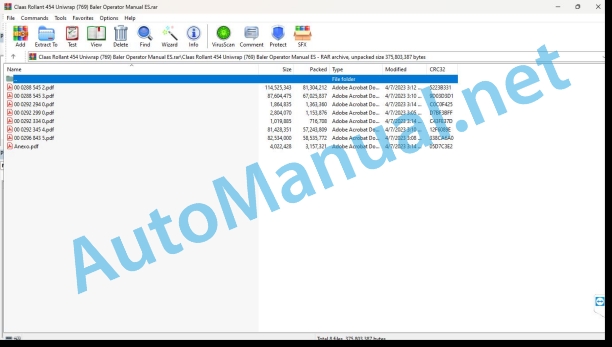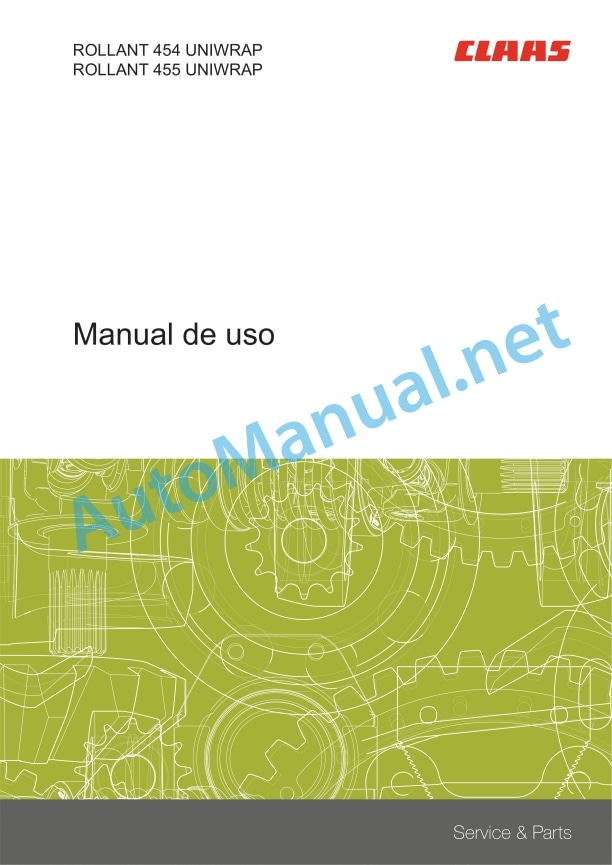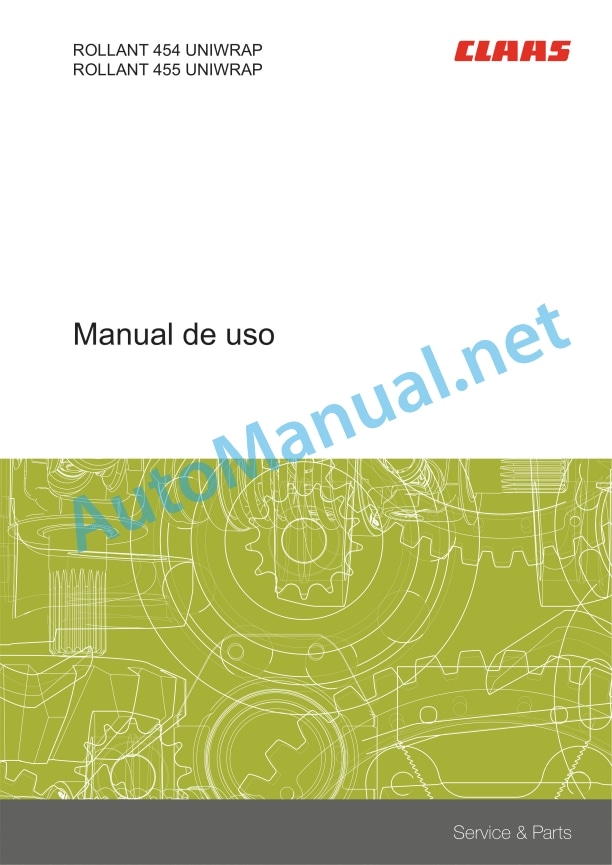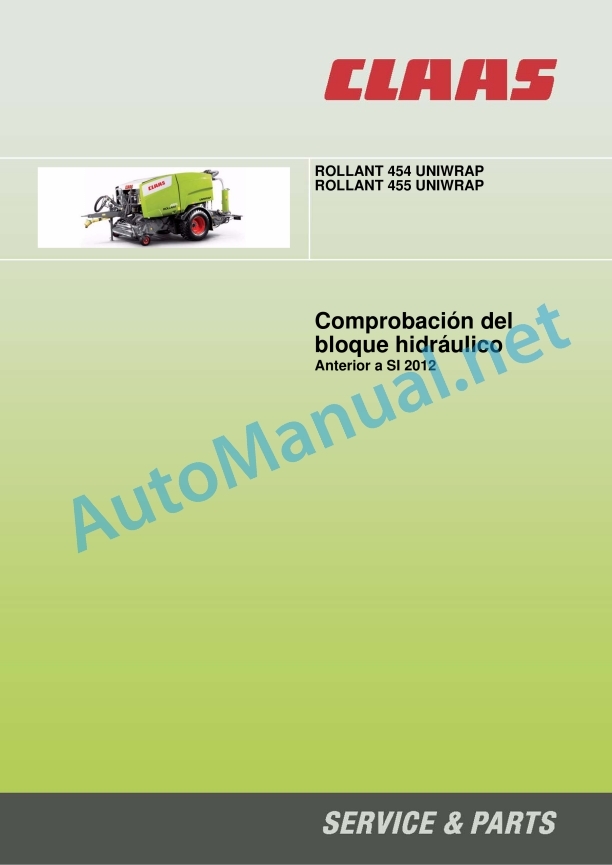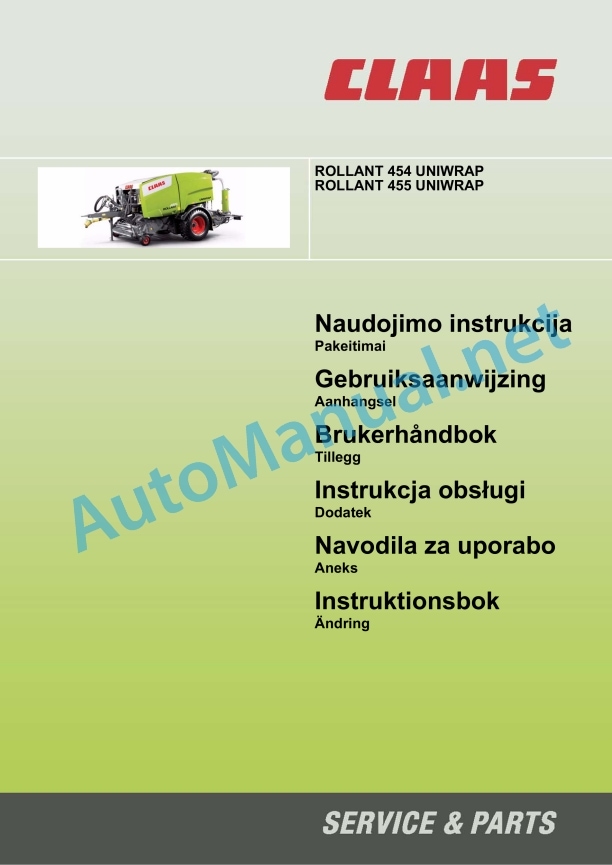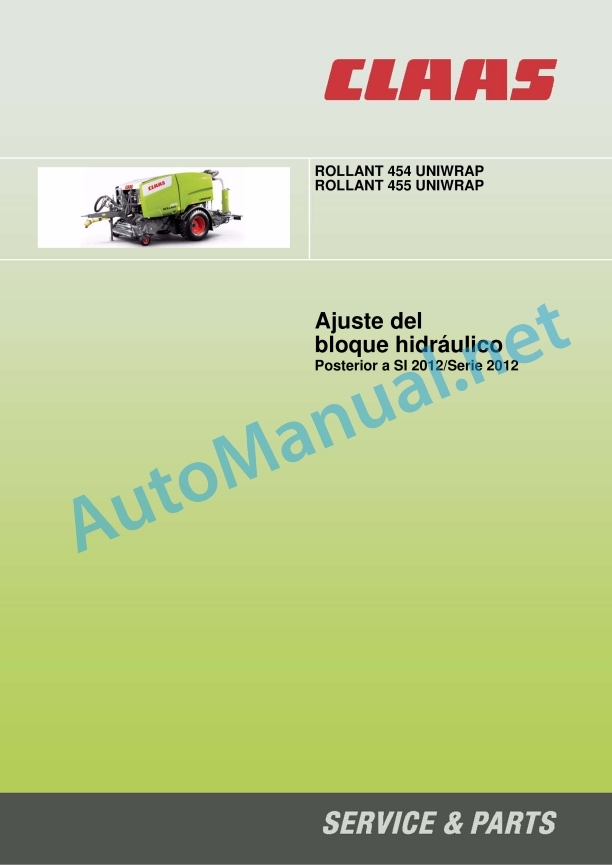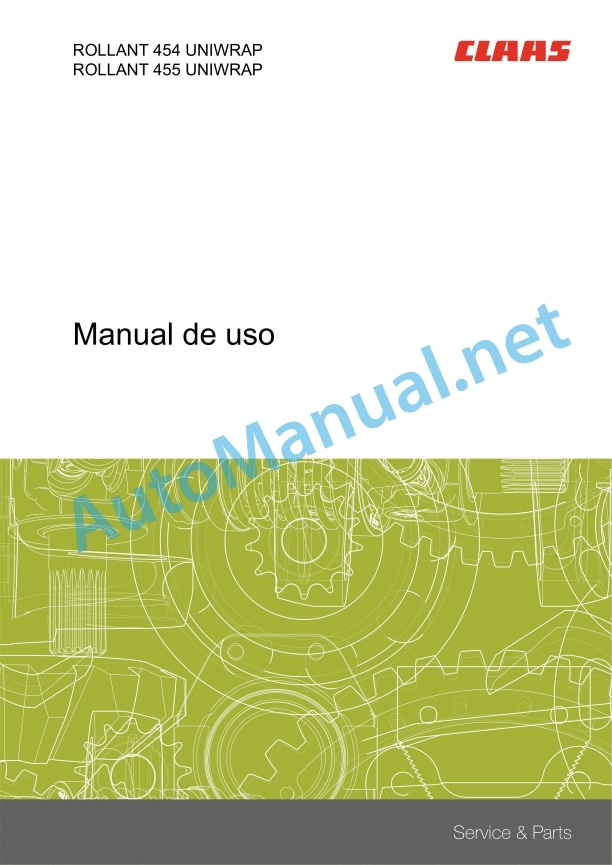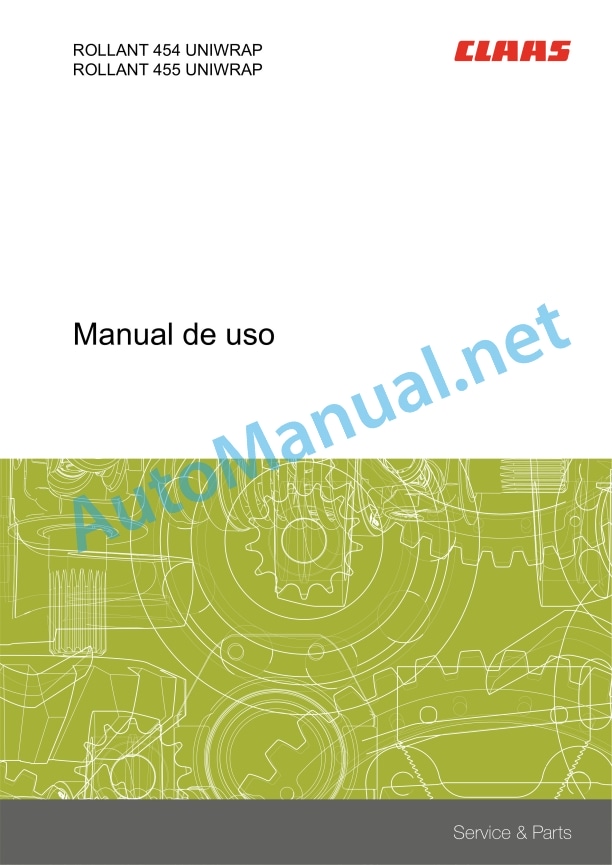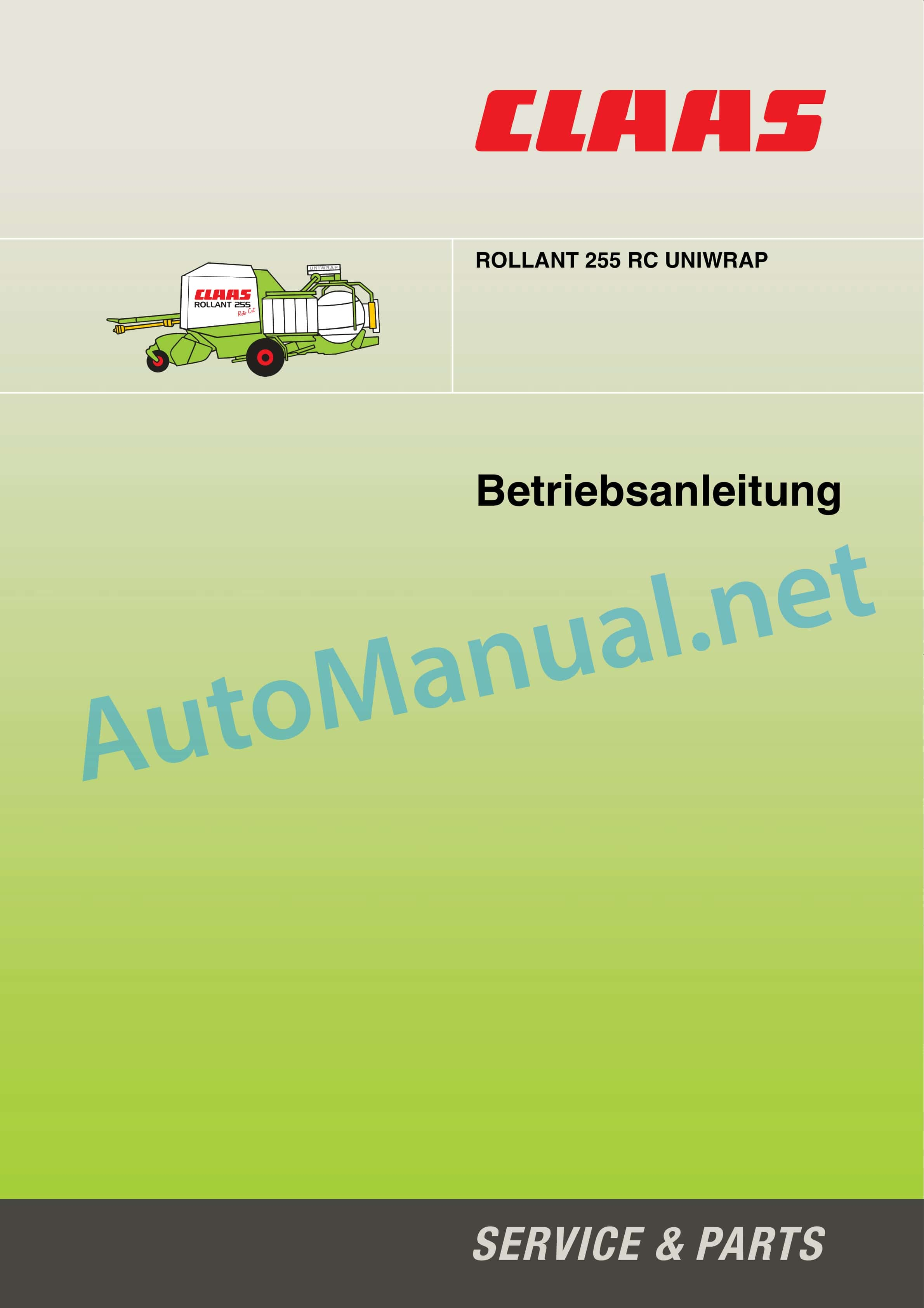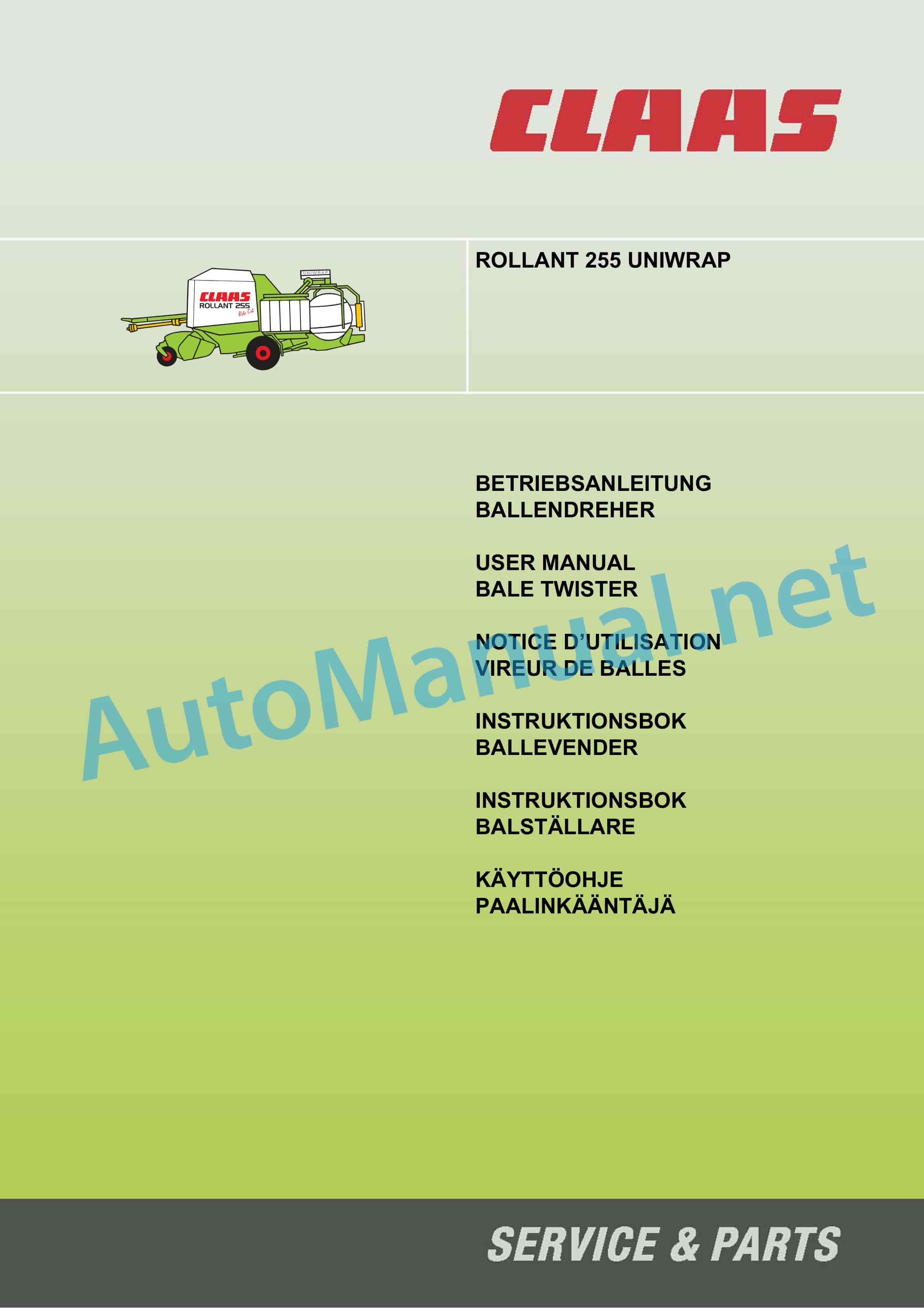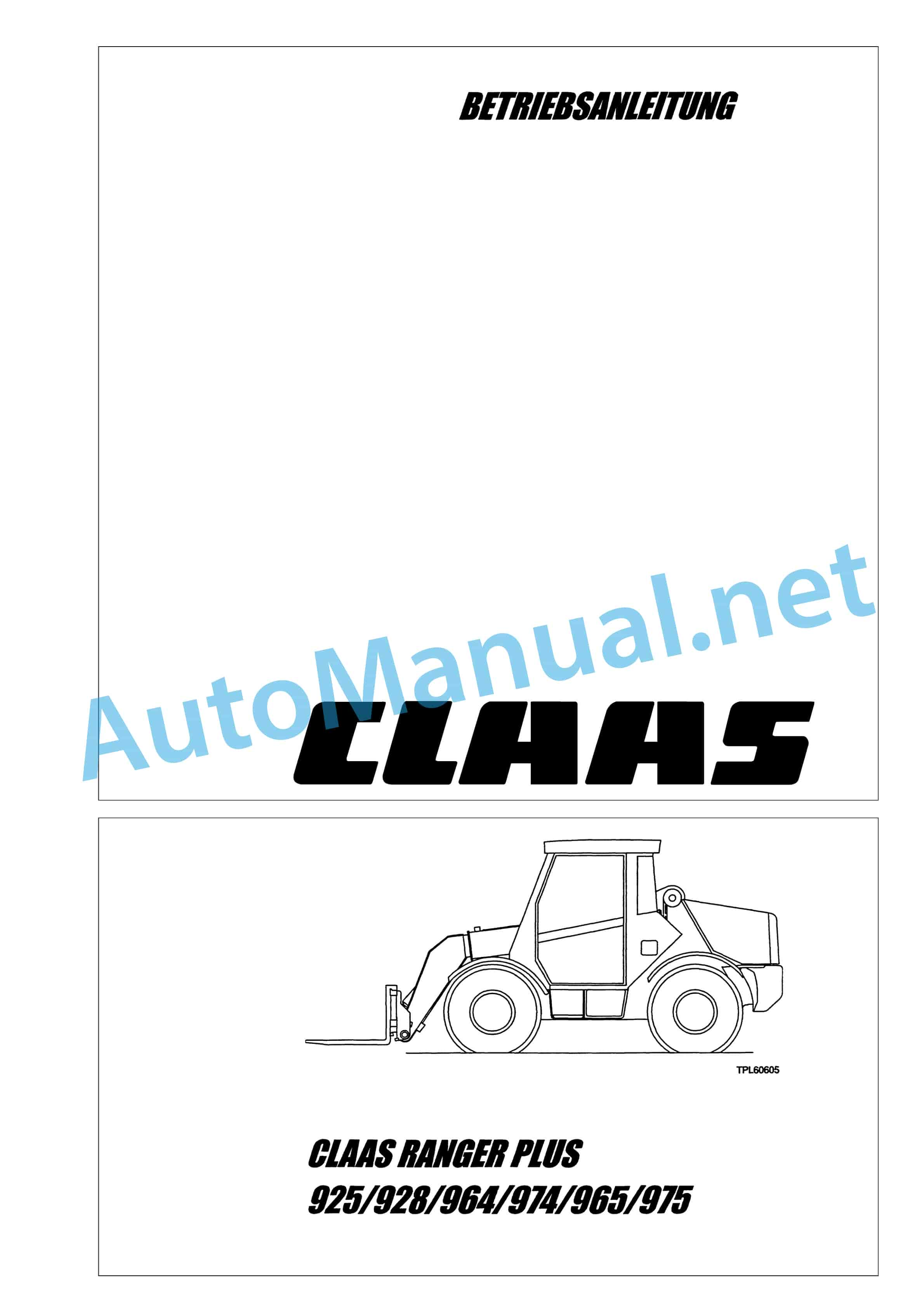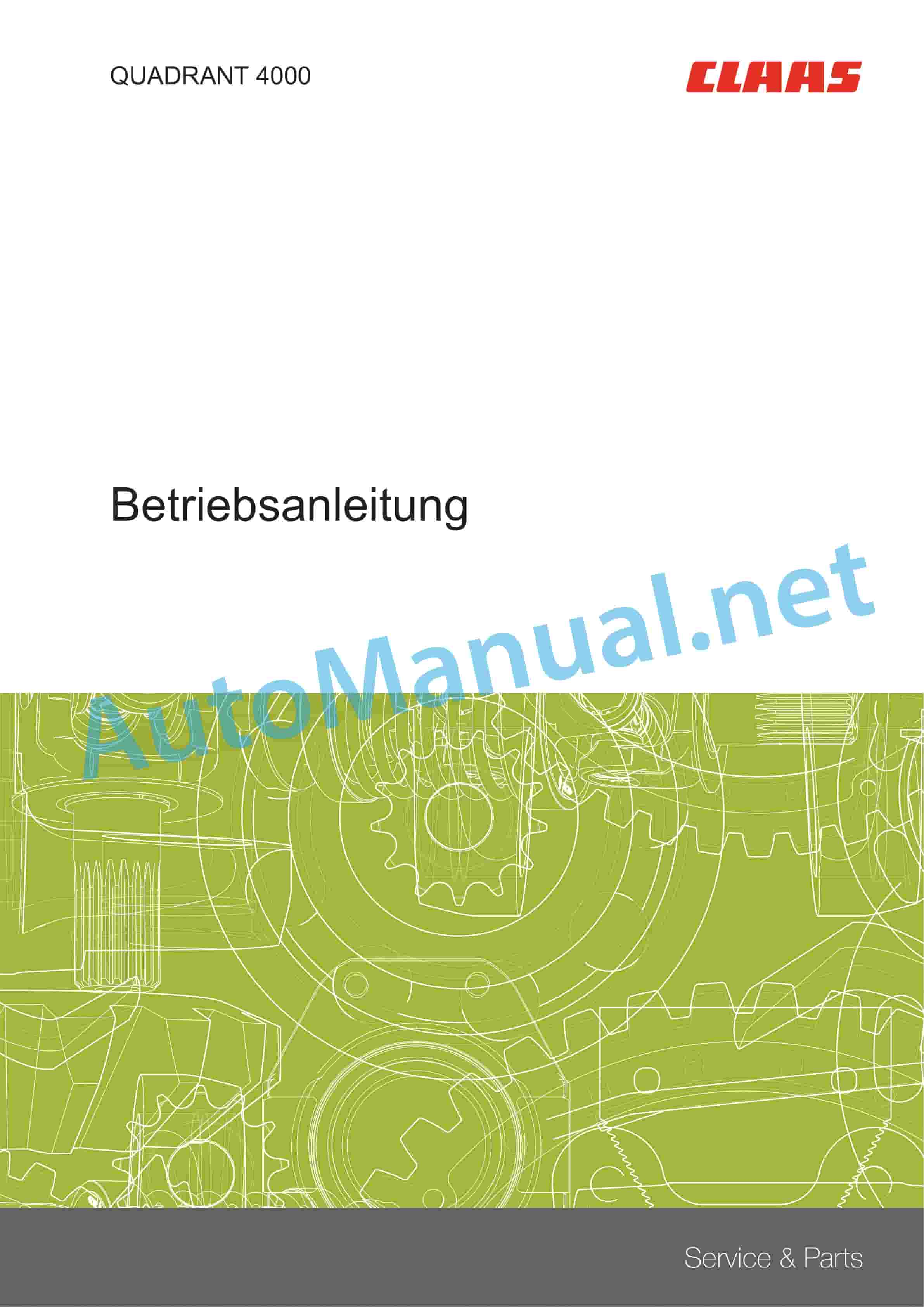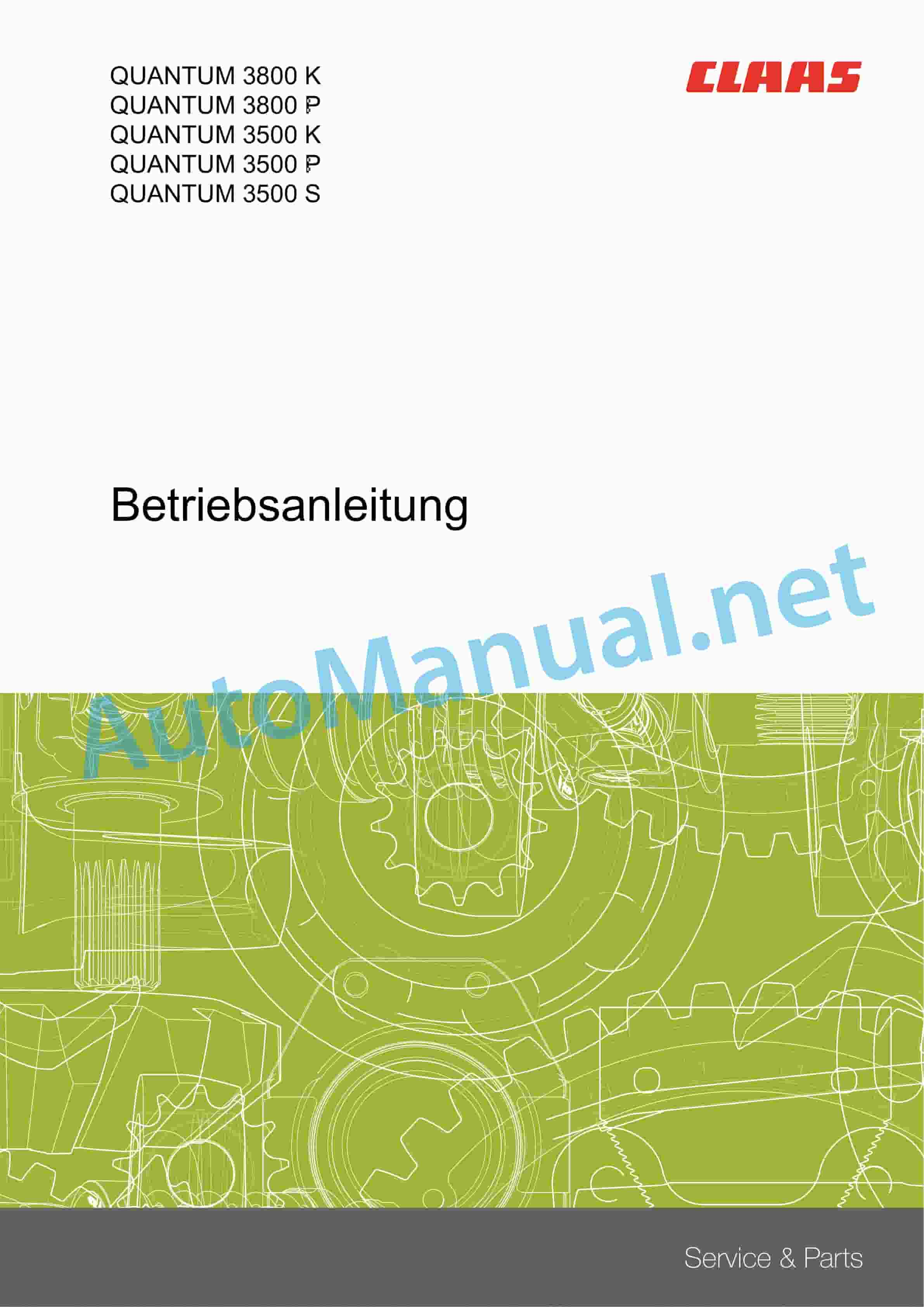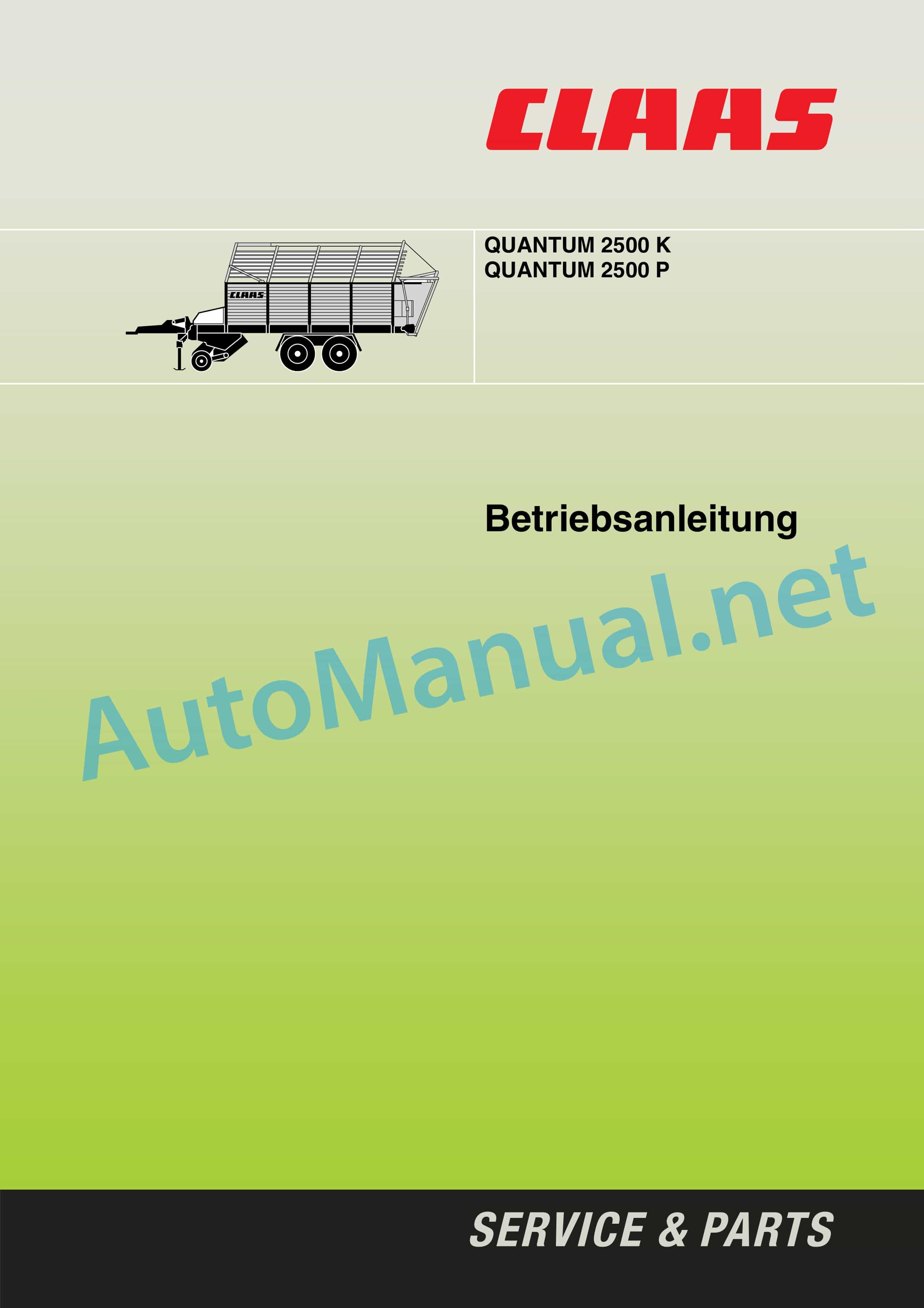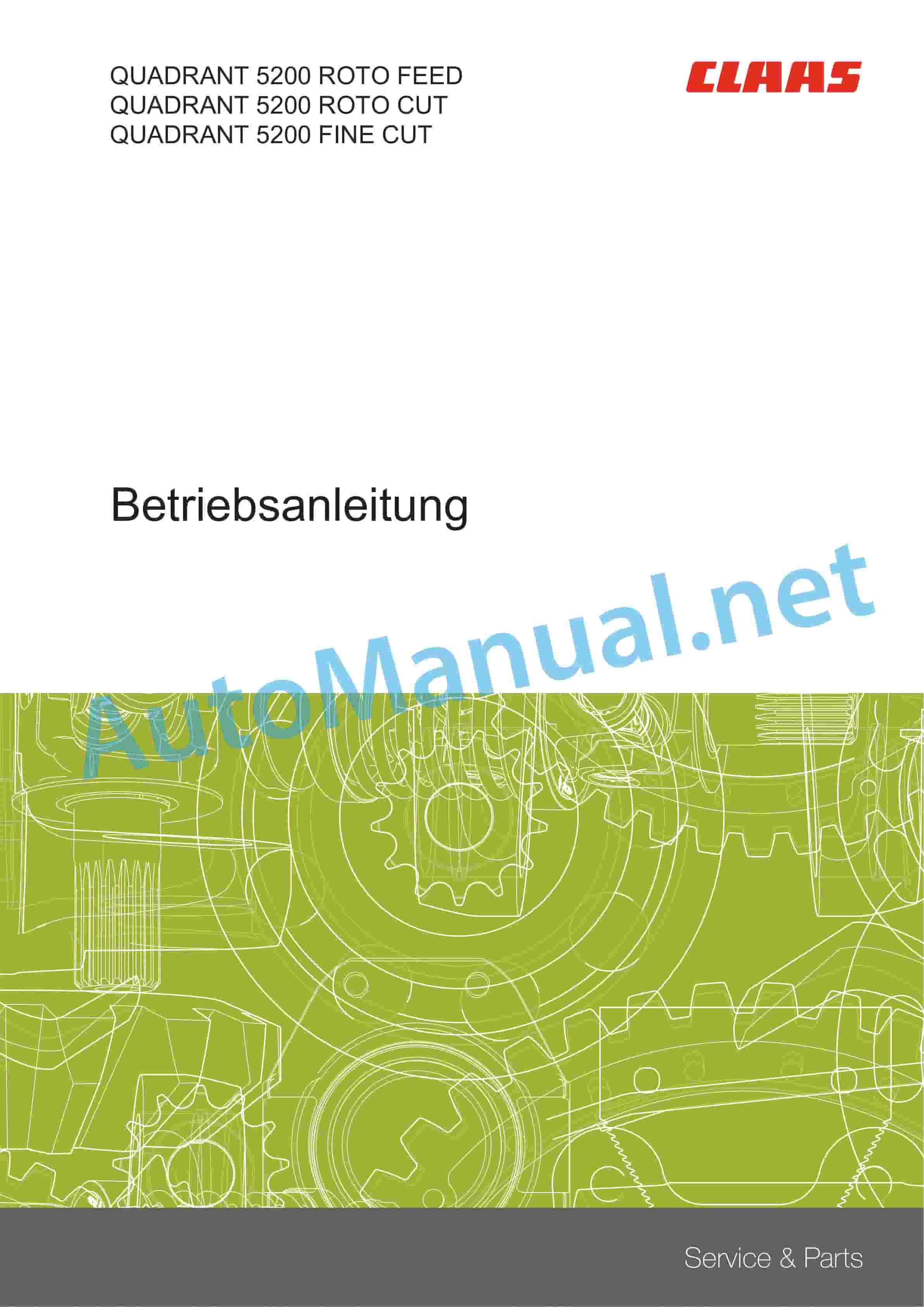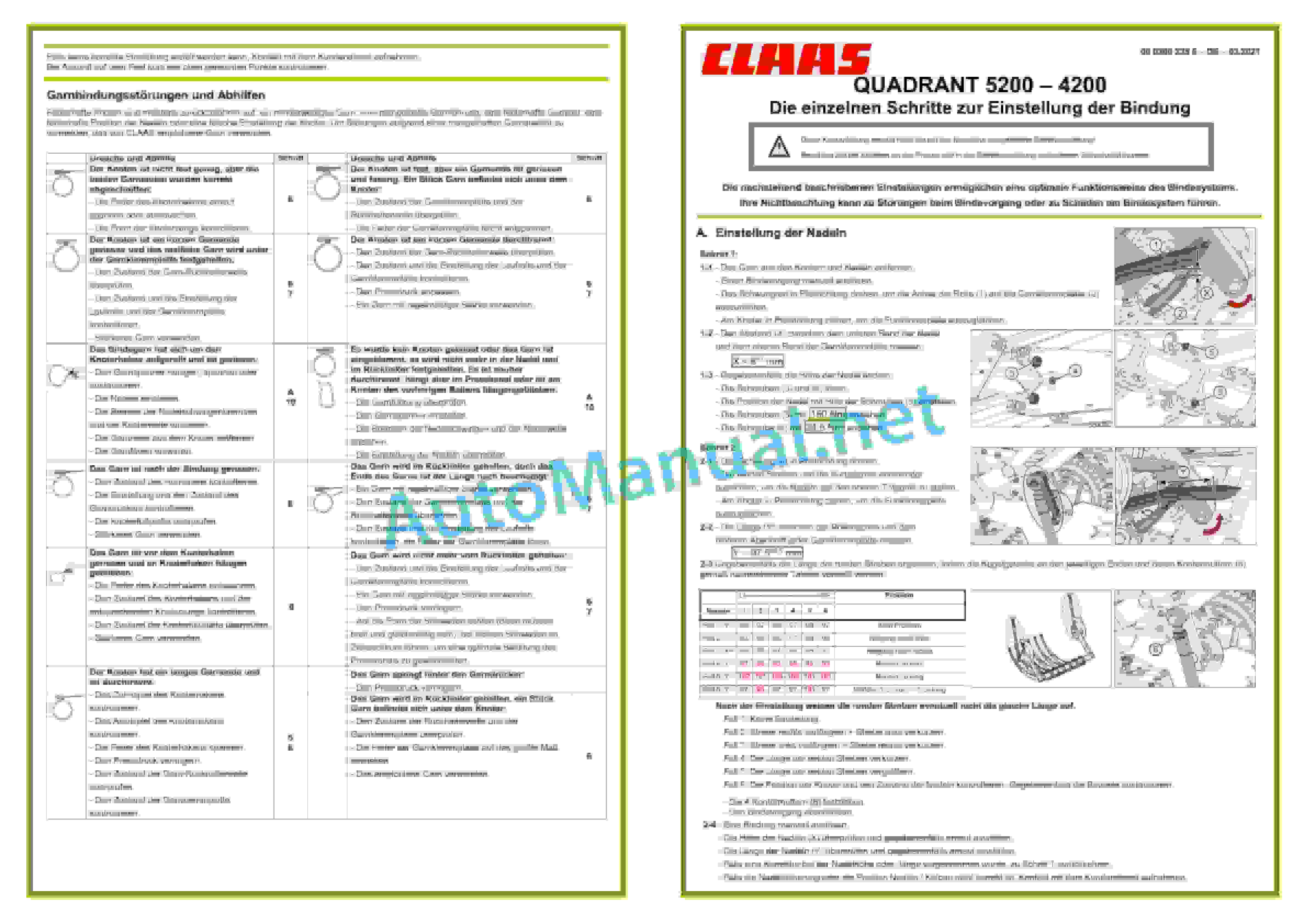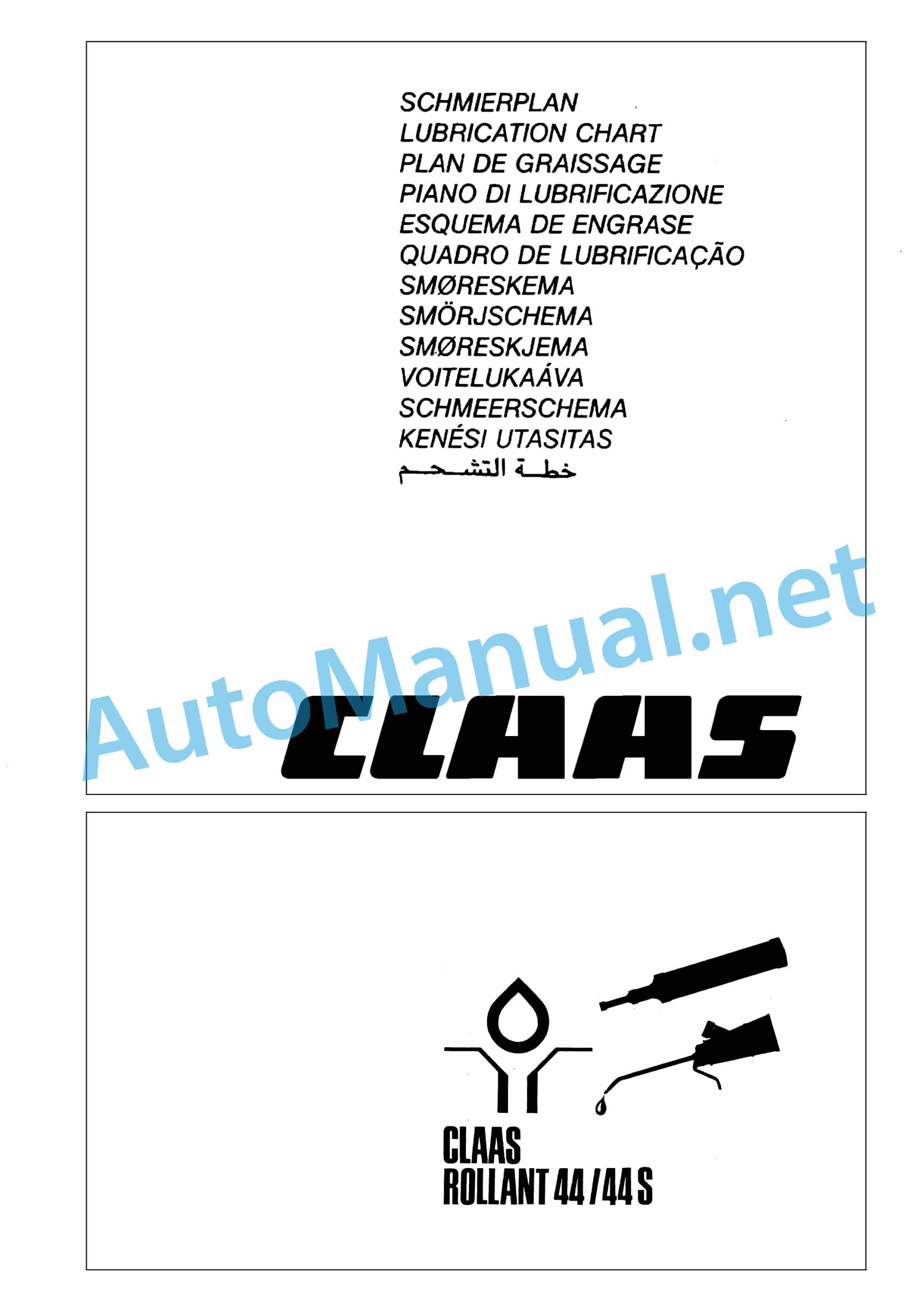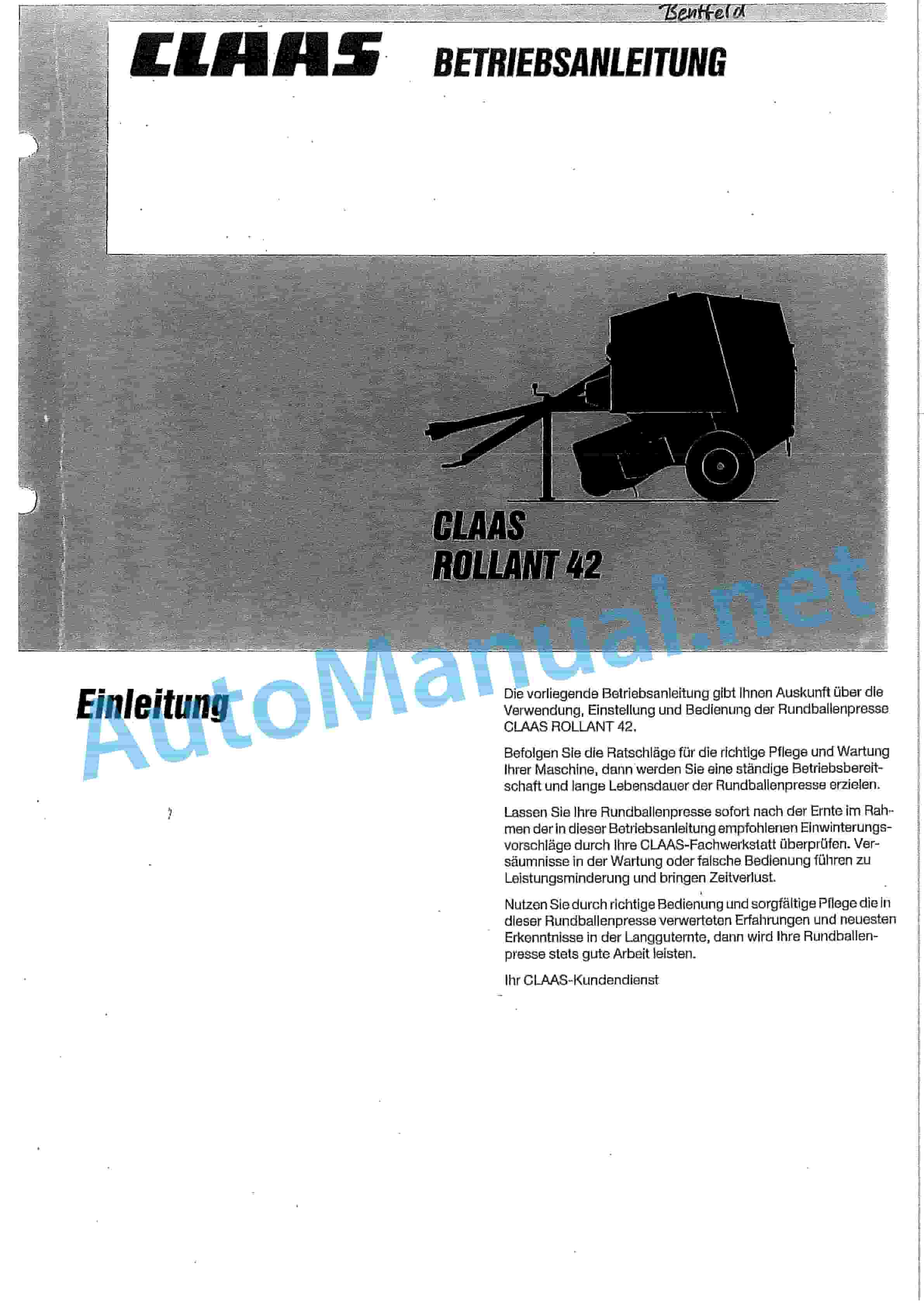Claas Rollant 454 Uniwrap (769) Baler Operator Manual ES
$44.00
- Brand: Claas
- Model: Rollant 454 Uniwrap (769) Baler
- Type Of Manual: Operator Manual
- Language: ES
- Format: PDF(s)
- Size: 258 MB
File List:
00 0288 545 2.pdf
00 0288 545 3.pdf
00 0292 294 0.pdf
00 0292 299 0.pdf
00 0292 334 0.pdf
00 0292 345 4.pdf
00 0296 843 5.pdf
Anexo.pdf
00 0288 545 2.pdf:
ROLLANT 454 UNIWRAPROLLANT 455 UNIWRAP
1. Introduction
1.1 General information
1.1.1 Application of this manual
1.1.2 Information relating to this instruction manual
1.1.3 Symbols and indications
1.1.4 Optional equipment
1.1.5 Qualified specialized workshop
1.1.6 Maintenance instructions
1.1.7 Information regarding warranty
1.1.8 Spare parts and technical issues
1.2 Proper application of the machine
1.2.1 Authorized use
1.2.2 Reasonably foreseeable misuse
2 Security
2.1 Recognize warning signs
2.1.1 Danger symbols
2.1.2 Keyword
2.2 Safety instructions
2.2.1 Meaning of the instruction manual
2.2.2 Observe graphic danger symbols and alarm indications
2.2.3 Requirements for all people working with the machine
2.2.4 Children in danger
2.2.5 Danger zones
2.2.6 Position yourself between the tractor and the machine
2.2.7 Accompanying persons
2.2.8 Couple the tractor with the machine
2.2.9 Risk of injury due to rotating shafts
2.2.10 Construction modifications
2.2.11 Optional equipment and spare parts
2.2.12 Control of the tractor in operation
2.2.13 Use only after correct start-up
2.2.14 Technical status
2.2.15 Danger due to machine breakdowns
2.2.16 Comply with technical limit values
2.2.17 Danger due to coasting parts
2.2.18 Maintain functional protection devices
2.2.19 Personal protective equipment
2.2.20 Wear appropriate clothing
2.2.21 Remove dirt and loose objects
2.2.22 Prepare the machine for road traffic
2.2.23 Dangers when driving on the road and in the countryside
2.2.24 Park the machine safely
2.2.25 Parking without supervision
2.2.26 Consumables that do not meet the requirements
2.2.27 Safe handling of consumables and auxiliary materials
2.2.28 Environmental protection and waste disposal
2.2.29 Fire protection
2.2.30 Very dangerous electrical discharge from overhead power lines
2.2.31 Electrical shock from electrical equipment
2.2.32 Liquids under pressure
2.2.33 Pressurized air
2.2.34 Hot surfaces
2.2.35 Work only on the stopped machine
2.2.36 Maintenance work and repair work
2.2.37 Machine parts and lifted loads
2.2.38 Risks derived from welding work
2.3 Graphic danger symbols
2.3.1 Structure of graphic hazard symbols
2.3.2 Location of safety stickers
3 Machine Description
3.1 Existing models
3.1.1 Designation of machines
3.2 Overview and functions
3.2.1 Left side
3.2.2 Right side
3.2.3 Identification of the rollers
3.3 Safety equipment
3.3.1 Signal lighting
3.3.2 Reflective equipment
Clearance reflectors*
3.3.3 Wheel chocks
3.3.4 Parking brake
Parking brake with lever control*
Parking brake with crank control*
Activate the parking brake.
Remove the parking brake.
3.3.5 Surety
3.3.6 Tailgate lock
3.3.7 Locking the plastic belt guide rollers*
3.3.8 Locking the pick-up
3.3.9 Fire extinguisher
3.3.10 Emergency stop
3.3.11 Safety arm
3.4 Work and service positions
3.4.1 General information
3.4.2 Top of the baler
3.4.3 Rear of the baler-wrapper
3.5 Identification plate and serial number
3.5.1 Spare parts and technical information
3.5.2 Serial number, identification number or VIN code
3.5.3 Machine identification plate
Identification plate for machines with European approval
Identification plate for machines without European approval
Identification plate for the countries of the Customs Union (Belarus, Kazakhstan, Russia)
3.5.4 Rudder identification plate*
3.5.5 Axle identification plate
3.6 Machine information
3.6.1 Location of information stickers
3.7 General operating principle
3.7.1 General information
3.7.2 Bale pressing cycle
3.7.3 Bale wrapping cycle
3.7.4 Complete bale pressing-wrapping cycle
3.7.5 Coating
3.7.6 Working modes
3.7.7 Mountain mode
3.8 Control terminal
3.8.1 Control terminal
3.8.2 ISOBUS connection
3.8.3 EASY on board
3.9 Transmission and drive
3.9.1 Power transmission
3.9.2 Main drive
3.9.3 Pick-up drive
3.9.4 Rotor drive
3.9.5 Drive Chains
3.10 Trailer support
3.10.1 Types of coupling
3.11 Harvest harvest
3.11.1 Pick-up
3.11.2 Compactor
3.11.3 Short straw plank (optional)
3.11.4 Reducer roller (optional)
3.12 Power supply unit
3.12.1 RotoCut cutting device
3.12.2 Automatic deactivation of the knives at the end of the bale
3.12.3 Unclogging the rotor
3.13 Pressing system
3.13.1 Pressing chamber and rollers
3.13.2 Pressing cycle
3.13.3 MPS (Maximum Pressure System or oscillating segment) hydraulically operated
3.14 Tying system
3.14.1 Tying categories and types
3.14.2 Comfort binding
3.14.3 Tying adjustment
3.14.4 Tying with mesh
3.14.5 Tied with plastic tape
3.14.6 Mesh reserve
3.14.7 Plastic tape / mesh reserve*
3.14.8 Mesh compartment* (tied with mesh)
3.14.9 Plastic tape / mesh compartment* (tied with plastic tape / mesh*)
3.14.10 Electromagnetic tying brake
3.15 Bale wrapper
3.15.1 Wrapping adjustment
3.15.2 Tilter
3.15.3 Wrapping table
3.15.4 Wrapping arm
3.15.5 Stretcher
3.15.6 Safety arm
3.15.7 Cutter
3.15.8 Wrapping Plastic Tape Box
3.16 Lubrication system
3.16.1 Automatic chain lubrication
3.17 Greasing system
3.17.1 General information
3.17.2 Manual centralized lubrication (option)
3.17.3 Mechanical automatic centralized lubrication (option)
3.17.4 Electric automatic centralized lubrication (option)
3.18 Brake
3.18.1 General information
3.18.2 Hydraulic braking
3.18.3 Active hydraulic braking
3.18.4 Pneumatic braking
3.19 Hydraulic system
3.19.1 Hydraulic blocks
3.19.2 Baler Hydraulic Block
3.19.3 Wrapper hydraulic block
3.19.4 Hydraulic circuit filter
3.19.5 Continuous hydraulic circulation*
3.19.6 Load Sensing (option)
3.20 Equipment
3.20.1 Ladder
3.20.2 Stirrup
3.20.3 Electronic module
3.20.4 Anti-theft*
3.20.5 Plastic Wrap Tape Compensator
3.20.6 Stretcher 82% (option)
3.20.7 Bale turner (optional)
3.20.8 Bale depositing mat (optional)
3.20.9 Work focus (optional)
3.20.10 Registration (depending on country)
3.20.11 Toolbox (optional)
4 Control and display instruments
4.1 COMMUNICATOR II
4.1.1 Presentation
4.1.2 Description of the COMMUNICATOR
00 0288 545 3.pdf:
User manual
1. Introduction
1.1 General information
1.1.1 Application of this manual
1.1.2 Information about this instruction manual
1.1.3 Symbols and indications
1.1.4 Optional equipment
1.1.5 Qualified specialized workshop
1.1.6 Maintenance instructions
1.1.7 Information regarding warranty
1.1.8 Spare parts and technical issues
1.2 Proper application of the machine
1.2.1 Authorized use
1.2.2 Reasonably foreseeable misuse
2 Security
2.1 Recognize warning signs
2.1.1 Danger symbols
2.1.2 Keyword
2.2 Safety instructions
2.2.1 Meaning of the instruction manual
2.2.2 Observe graphic danger symbols and alarm indications
2.2.3 Requirements for all people working with the machine
2.2.4 Children in danger
2.2.5 Dangerous areas
2.2.6 Position yourself between the tractor and the machine
2.2.7 Accompanying persons
2.2.8 Couple the tractor with the machine
2.2.9 Risk of injury due to rotating shafts
2.2.10 Construction modifications
2.2.11 Optional equipment and spare parts
2.2.12 Control of the tractor in operation
2.2.13 Use only after correct start-up
2.2.14 Technical status
2.2.15 Danger due to machine breakdowns
2.2.16 Comply with technical limit values
2.2.17 Danger due to coasting parts
2.2.18 Maintain functional protection devices
2.2.19 Personal protective equipment
2.2.20 Wear appropriate clothing
2.2.21 Remove dirt and loose objects
2.2.22 Prepare the machine for road traffic
2.2.23 Dangers when driving on the road and in the countryside
2.2.24 Park the machine safely
2.2.25 Parking without supervision
2.2.26 Consumables that do not meet the requirements
2.2.27 Safe handling of consumables and auxiliary materials
2.2.28 Environmental protection and waste disposal
2.2.29 Fire protection
2.2.30 Very dangerous electrical discharge from overhead power lines
2.2.31 Electrical shock from electrical equipment
2.2.32 Liquids under pressure
2.2.33 Pressurized air
2.2.34 Hot surfaces
2.2.35 Work only on the stopped machine
2.2.36 Maintenance work and repair work
2.2.37 Machine parts and lifted loads
2.2.38 Risks derived from welding work
2.3 Graphic danger symbols
2.3.1 Structure of graphic hazard symbols
2.3.2 Location of safety stickers
3 Machine Description
3.1 Existing models
3.1.1 Designation of machines
3.2 Overview and functions
3.2.1 Left side
3.2.2 Right side
3.2.3 Identification of the rollers
3.3 Safety equipment
3.3.1 Signal lighting
3.3.2 Reflective equipment
Clearance reflectors*
3.3.3 Wheel chocks
3.3.4 Parking brake
Parking brake with lever control*
Parking brake with crank control*
Activate the parking brake.
Remove the parking brake.
3.3.5 Surety
3.3.6 Tailgate lock
3.3.7 Locking the plastic belt guide rollers*
3.3.8 Locking the pick-up
3.3.9 Fire extinguisher
3.3.10 Emergency stop
3.3.11 Safety arm
3.4 Work and service positions
3.4.1 General information
3.4.2 Top of the baler
3.4.3 Rear of the baler-wrapper
3.5 Identification plate and serial number
3.5.1 Spare parts and technical information
3.5.2 Serial number, identification number or VIN code
3.5.3 Machine identification plate
Identification plate for machines with European approval
Identification plate for machines without European approval
Identification plate for the countries of the Customs Union (Belarus, Kazakhstan, Russia)
3.5.4 Rudder identification plate*
3.5.5 Axle identification plate
3.6 Machine information
3.6.1 Location of information stickers
3.7 General operating principle
3.7.1 General information
3.7.2 Bale pressing cycle
3.7.3 Bale wrapping cycle
3.7.4 Complete bale pressing-wrapping cycle
3.7.5 Coating
3.7.6 Working modes
3.7.7 Mountain mode
3.8 Control terminal
3.8.1 Control terminal
3.8.2 COMMUNICATOR*
3.8.3 ISOBUS connection
3.9 Transmission and drive
3.9.1 Power transmission
3.9.2 Main drive
3.9.3 Pick-up drive
3.9.4 Rotor drive
3.9.5 Drive Chains
3.10 Trailer support
3.10.1 Types of coupling
3.11 Harvest harvest
3.11.1 Pick-up
3.11.2 Compactor
3.11.3 Short straw plank (optional)
3.11.4 Reducer roller (optional)
3.12 Power supply unit
3.12.1 ROTO CUT cutting device
3.12.2 Automatic deactivation of the knives at the end of the bale
3.12.3 Unclogging the rotor
3.13 Pressing system
3.13.1 Pressing chamber and rollers
3.13.2 Pressing cycle
3.13.3 MPS (Maximum Pressure System or oscillating segment) hydraulically operated
3.14 Tying system
3.14.1 Tying categories and types
3.14.2 Comfort binding
3.14.3 Tying adjustment
3.14.4 Tying with mesh
3.14.5 Tied with plastic tape
3.14.6 Mesh reserve
3.14.7 Plastic tape / mesh reserve*
3.14.8 Mesh compartment* (tied with mesh)
3.14.9 Plastic tape / mesh compartment* (tied with plastic tape / mesh*)
3.14.10 Electromagnetic tying brake
3.15 Bale wrapper
3.15.1 Wrap adjustment
3.15.2 Tilter
3.15.3 Wrapping table
3.15.4 Wrapping arm
3.15.5 Stretcher
3.15.6 Safety arm
3.15.7 Cutter
3.15.8 Wrapping Plastic Tape Box
3.16 Lubrication system
3.16.1 Automatic chain lubrication
3.17 Greasing system
3.17.1 General information
3.17.2 Manual centralized lubrication (option)
3.17.3 Mechanical automatic centralized lubrication (option)
3.17.4 Electric automatic centralized lubrication (option)
3.18 Brake
3.18.1 General information
3.18.2 Hydraulic braking
3.18.3 Active hydraulic braking
3.18.4 Pneumatic braking
3.19 Hydraulic system
3.19.1 Hydraulic blocks
3.19.2 Baler Hydraulic Block
3.19.3 Wrapper hydraulic block
3.19.4 Hydraulic circuit filter
3.19.5 Continuous hydraulic circulation*
3.19.6 Load Sensing (option)
3.20 Equipment
3.20.1 Ladder
3.20.2 Stirrup
3.20.3 Electronic module
3.20.4 Anti-theft*
3.20.5 Plastic Wrap Tape Compensator
3.20.6 Stretcher 82% (option)
3.20.7 Bale turner (optional)
3.20.8 Bale depositing mat (optional)
3.20.9 Work focus* and camera*
3.20.10 Registration (depending on country)
3.20.11 Toolbox (optional)
4 Control and display instruments
4.1 CEMIS 700
4.1.1 Presentation
4.1.2 Description of the CEMIS 700
4.1.3 Description of the CEMIS 700
4.1.4 Description of the CEMIS 700
4.1.5 Description of the CEMIS 700
4.1.6 Description of the
4.2 COMMUNICATOR II
4.2.1 Presentation
4.3 ISOBUS Terminal
4.3.1 Presentation
4.3.2 General information
4.4 CLAAS Medium Terminal
4.4.1 Presentation
4.4.2 Screen
4.4.3 Key identification
4.4.4 Home page
4.4.5 Description of the CLAAS Medium Terminal menus
5 Technical data
5.1 Baler
5.1.1 Dimensions
5.1.2 Weight
5.1.3 Hookup
5.1.4 Cardan shaft
5.1.5 Feeding and pressing
5.1.6 Tying device
5.1.7 Wrapper
5.1.8 Plastic wrapping tape
5.1.9 Wheels
5.1.10 Braking
5.1.11 Hydraulic circuit
5.1.12 Greasing and lubrication
5.1.13 Screw tightening torques
5.1.14 Sound levels
5.2 Safety devices
5.2.1 Security screw
5.2.2 Torque limiter
5.2.3 Wrapping machine
5.3 Inputs
5.3.1 Lubricants
5.3.2 Tying mesh
5.3.3 Plastic tying tape
5.3.4 Plastic wrapping tape
5.4 Tractor
5.4.1 Required power
5.4.2 Maximum authorized mass of the towing vehicle
5.4.3 Hooking
5.4.4 PTO
5.4.5 Electrical connections
5.4.6 Hydraulic connections
5.4.7 Hydraulic circuit and oil
5.4.8 Braking
6 Preparation of the machine
6.1 Turn off the machine and secure it
6.1.1 Stop and secure the tractor and machine
6.2 Adapt the tractor
6.2.1 Check the tractor power take-off protection device
6.2.2 Adapt the tractor’s pneumatic brake equipment
6.2.3 CEMIS 700* assembly
6.2.4 Battery cable*
6.3 Adapt the machine
6.3.1 Recommendations
6.3.2 Adaptation of the hitch to the fork / hitch to the oscillating bar
6.3.3 Cardan shaft coupling
6.3.4 Adaptation of the cardan shaft length
6.4 Hooking up the machine
6.4.1 Rubber buffer
6.4.2 Cardan shaft safety regulations
6.4.3 Positioning the cardan shaft
Gimbal support
Checking the steering angle
6.4.4 Machine not equipped with Load-Sensing
6.4.5 Machine equipped with Load-Sensing and tractor with Load-Sensing sockets
6.4.6 Machine equipped with Load-Sensing and tractor without Load-Sensing sockets
6.4.7 Hydraulic brake
6.4.8 Active hydraulic brake
6.4.9 Air brake
6.4.10 Identification of electrical cables
6.4.11 Lighting
6.4.12 Power supply to the baler and CEMIS 700
6.4.13 Baler power supply with ISOBUS cable
6.4.14 Connect the camera*
6.5 Prepare for use at work
6.5.1 Pick-up wheels
6.5.2 Pick-up height
6.5.3 Compactor
6.5.4 Reducing rollers
6.6 Axis
6.6.1 Position of the axle shafts
6.6.2 Change of position of the axle shafts
6.7 Tying with mesh
6.7.1 Mesh quality
6.7.2 Mesh placement (mesh tying*)
6.7.3 Net tying brake adjustment
6.8 Tied with plastic tape/mesh
6.8.1 Mesh quality
6.8.2 Quality of plastic tying tape
6.8.3 Placing the roll of plastic tape* or mesh* (tied with plastic tape/mesh*)
6.8.4 Placing the plastic tape (tied with plastic tape / mesh*)
6.8.5 Placement of the mesh (tied with plastic tape / mesh*)
6.8.6 Adjustment of the tying brake with plastic tape / mesh
6.9 Cutting device
6.9.1 Safety regulations
6.9.2 Control
6.9.3 Placing the blades
6.9.4 Placing the false blades*
6.9.5 Unused blades and false blades
6.10 Pressing chamber
6.10.1 Setting the pressing pressure
6.10.2 MPS adjustment
6.11 Bale wrapper
6.11.1 Wrapping plastic tape box
6.11.2 Quality of plastic wrapping tape
6.11.3 Placing the roll of plastic wrapping tape
6.11.4 Placing the plastic wrapping tape on the cutter (depending on equipment)
6.11.5 Coating
6.12 Load the machine
6.12.1 Baler stowage
6.12.2 Lifting points
6.12.3 Elevation
7 Management
7.1 General information
7.1.1 Baler user
7.1.2 Wrapping
7.1.3 Opening of doors, covers and crankcases
Side gates
Left pick-up crankcase
Top deck
7.1.4 Plastic tape box doors
7.1.5 Resetting the tying blade
7.2 Movements with the baler
7.2.1 Equipment control
7.2.2 Preparations for transportation
7.2.3 Road travel
7.2.4 Arrival at the field
7.2.5 Moving around the field
7.2.6 Parking
7.3 Before each use
7.3.1 Cardan shaft
7.3.2 Reminders
7.3.3 Baler maintenance
7.3.4 Equipment control
7.3.5 Safety devices
7.3.6 Periods of intense heat
7.4 Commissioning in the field
7.4.1 Usage tips
7.4.2 Tips for using tying with plastic tape*
Rolls of plastic tape
Crimping/tying parameters
Bale covering
Bale exit from the pressing chamber
Extreme conditions
7.4.3 Bale turner (optional)
Placement in working position
Placing in transport position
Turner disassembly
Spinner assembly
7.4.4 Bale depositing mat (optional)
7.4.5 Commissioning of the machine
7.4.6 Coating
7.4.7 Mountain mode
7.5 Pick-up
7.5.1 Important
7.6 Tied
7.6.1 Bale adjustments
7.6.2 Changing the roll of plastic tape or mesh
7.7 Bale parameters
7.7.1 Bale adjustments
7.8 CEMIS 700
7.8.1 Display and navigation
7.8.2 Using the virtual keyboard
7.8.3 Usage parameter settings
Baler usage parameters
Crimping/tying parameters
Tying type selection*
Adjustment
Number of turns of plastic tape* or mesh*
Adjustment
Tying brake force
Adjustment
Tying time with plastic tape*
Adjustment
Net tying time*
Adjustment
Adjustment of tying parameters with plastic tape*
Adjustment
Bale rotation before wrapping*
Adjustment
pressing pressure
Adjustment
Claas Operator Manual PDF
Claas RANGER 928, 925, 920 und PLUS (510) Telehandlers Operator Manual DE
Claas Operator Manual PDF
Claas QUANTUM 3800 K 3500 P-K-S (613) Loader Wagons Operator Manual DE
Claas Operator Manual PDF
